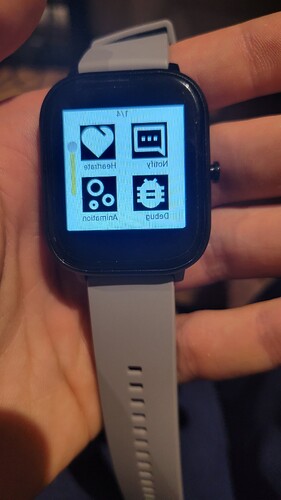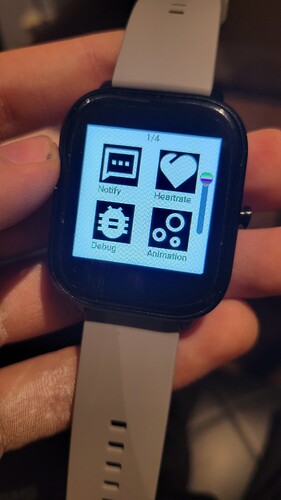Here are both display.h and display.cpp file of the project.
display.h:
#pragma once
#include “Arduino.h”
#include “pinout.h”
#define ST77XX_SLPIN 0x10
#define ST77XX_SLPOUT 0x11
#define ST77XX_DISPOFF 0x28
#define ST77XX_DISPON 0x29
void init_display();
void display_enable(bool state);
void inc_tick();
void setAddrWindowDisplay(uint32_t x, uint32_t y, uint32_t w, uint32_t h);
void initDisplay();
void spiCommand(uint8_t d);
void startWrite_display(void);
void endWrite_display(void);
display.cpp:
#include “display.h”
#include <lvgl.h>
#include “fast_spi.h”
#include “images.h”
#include “battery.h”
#include “touch.h”
#include “accl.h”
#include “menu.h”
#include “ble.h”
#include “heartrate.h”
#include “backlight.h”
#include “inputoutput.h”
#include “bootloader.h”
#include “time.h”
#include “push.h”
#define buffer_lcd_size LV_HOR_RES_MAX * 30
static lv_disp_buf_t disp_buf;
static lv_color_t buf[buffer_lcd_size];
void my_disp_flush(lv_disp_drv_t *disp, const lv_area_t *area, lv_color_t *color_p)
{
uint32_t w = (area->x2 - area->x1 + 1);
uint32_t h = (area->y2 - area->y1 + 1);
startWrite_display();
setAddrWindowDisplay(area->x1, area->y1, w, h);
write_fast_spi(reinterpret_cast<const uint8_t *>(color_p), (w * h * 2));
endWrite_display();
lv_disp_flush_ready(disp);
}
bool my_touchpad_read(lv_indev_drv_t * indev_driver, lv_indev_data_t * data)
{
bool touched = false;
touch_data_struct touch_data;
if (swipe_enabled()) {
get_read_touch();
touch_data = get_touch();
touched = (touch_data.event == 2) ? LV_INDEV_STATE_PR : LV_INDEV_STATE_REL;
get_new_touch_interrupt();
} else {
if (get_new_touch_interrupt()) {
touch_data = get_touch();
touched = (touch_data.gesture == TOUCH_SINGLE_CLICK) ? LV_INDEV_STATE_PR : LV_INDEV_STATE_REL;
} else {
touched = LV_INDEV_STATE_REL;
}
}
data->state = touched;
data->point.x = touch_data.xpos;
data->point.y = touch_data.ypos;
return false;
}
void inc_tick() {
lv_tick_inc(40);
}
void init_display() {
initDisplay();
lv_init();
lv_disp_buf_init(&disp_buf, buf, NULL, buffer_lcd_size);
lv_disp_drv_t disp_drv;
lv_disp_drv_init(&disp_drv);
disp_drv.hor_res = 240;
disp_drv.ver_res = 240;
disp_drv.flush_cb = my_disp_flush;
disp_drv.buffer = &disp_buf;
lv_disp_drv_register(&disp_drv);
lv_indev_drv_t indev_drv;
lv_indev_drv_init(&indev_drv);
indev_drv.type = LV_INDEV_TYPE_POINTER;
indev_drv.read_cb = my_touchpad_read;
lv_indev_drv_register(&indev_drv);
lv_theme_t *th = lv_theme_night_init(10, NULL);
lv_theme_set_current(th);
}
void display_enable(bool state) {
uint8_t temp[2];
startWrite_display();
if (state) {
spiCommand(ST77XX_DISPON);
spiCommand(ST77XX_SLPOUT);
} else {
spiCommand(ST77XX_SLPIN);
spiCommand(ST77XX_DISPOFF);
}
endWrite_display();
}
void setAddrWindowDisplay(uint32_t x, uint32_t y, uint32_t w, uint32_t h)
{
uint8_t temp[4];
//y += 180; // when rotated screen
spiCommand(0x2A);
temp[0] = (x >> 8);
temp[1] = x;
temp[2] = ((x + w - 1) >> 8);
temp[3] = (x + w - 1);
write_fast_spi(temp, 4);
spiCommand(0x2B);
temp[0] = (y >> 8 );
temp[1] = y;
temp[2] = ((y + h - 1) >> 8);
temp[3] = ((y + h - 1) & 0xFF);
write_fast_spi(temp, 4);
spiCommand(0x2C);
}
void initDisplay() {
uint8_t temp[25];
pinMode(LCD_CS, OUTPUT);
pinMode(LCD_RS, OUTPUT);
pinMode(LCD_RESET, OUTPUT);
pinMode(LCD_DET, OUTPUT);
digitalWrite(LCD_CS , HIGH);
digitalWrite(LCD_RS , HIGH);
digitalWrite(LCD_RESET, HIGH);
delay(20);
digitalWrite(LCD_RESET, LOW);
delay(100);
digitalWrite(LCD_RESET, HIGH);
delay(100);
startWrite_display();
spiCommand(54);
temp[0] = 0x00;//0xC0;// when rotated screen
write_fast_spi(temp, 1);
spiCommand(58);
temp[0] = 5;
write_fast_spi(temp, 1);
spiCommand(178);
temp[0] = 12;
temp[1] = 12;
temp[2] = 0;
temp[3] = 51;
temp[4] = 51;
write_fast_spi(temp, 5);
spiCommand(183);
temp[0] = 53;
write_fast_spi(temp, 1);
spiCommand(187);
temp[0] = 25;
write_fast_spi(temp, 1);
spiCommand(192);
temp[0] = 44;
write_fast_spi(temp, 1);
spiCommand(194);
temp[0] = 1;
write_fast_spi(temp, 1);
spiCommand(195);
temp[0] = 18;
write_fast_spi(temp, 1);
spiCommand(196);
temp[0] = 32;
write_fast_spi(temp, 1);
spiCommand(198);
temp[0] = 15;
write_fast_spi(temp, 1);
spiCommand(208);
temp[0] = 164;
temp[1] = 161;
write_fast_spi(temp, 2);
spiCommand(224);
temp[0] = 208;
temp[1] = 4;
temp[2] = 13;
temp[3] = 17;
temp[4] = 19;
temp[5] = 43;
temp[6] = 63;
temp[7] = 84;
temp[8] = 76;
temp[9] = 24;
temp[10] = 13;
temp[11] = 11;
temp[12] = 31;
temp[13] = 35;
write_fast_spi(temp, 14);
spiCommand(225);
temp[0] = 208;
temp[1] = 4;
temp[2] = 12;
temp[3] = 17;
temp[4] = 19;
temp[5] = 44;
temp[6] = 63;
temp[7] = 68;
temp[8] = 81;
temp[9] = 47;
temp[10] = 31;
temp[11] = 31;
temp[12] = 32;
temp[13] = 35;
write_fast_spi(temp, 14);
spiCommand(33);
spiCommand(17);
delay(120);
spiCommand(41);
spiCommand(0x11);
spiCommand(0x29);
endWrite_display();
}
void spiCommand(uint8_t d) {
digitalWrite(LCD_RS , LOW);
write_fast_spi(&d, 1);
digitalWrite(LCD_RS , HIGH);
}
void startWrite_display(void) {
enable_spi(true);
digitalWrite(LCD_CS , LOW);
}
void endWrite_display(void) {
digitalWrite(LCD_CS , HIGH);
enable_spi(false);
}


